MITSUBISHI LANCER EVOLUTION 2007 Service Repair Manual
Manufacturer: MITSUBISHI, Model Year: 2007, Model line: LANCER EVOLUTION, Model: MITSUBISHI LANCER EVOLUTION 2007Pages: 1449, PDF Size: 56.82 MB
Page 851 of 1449
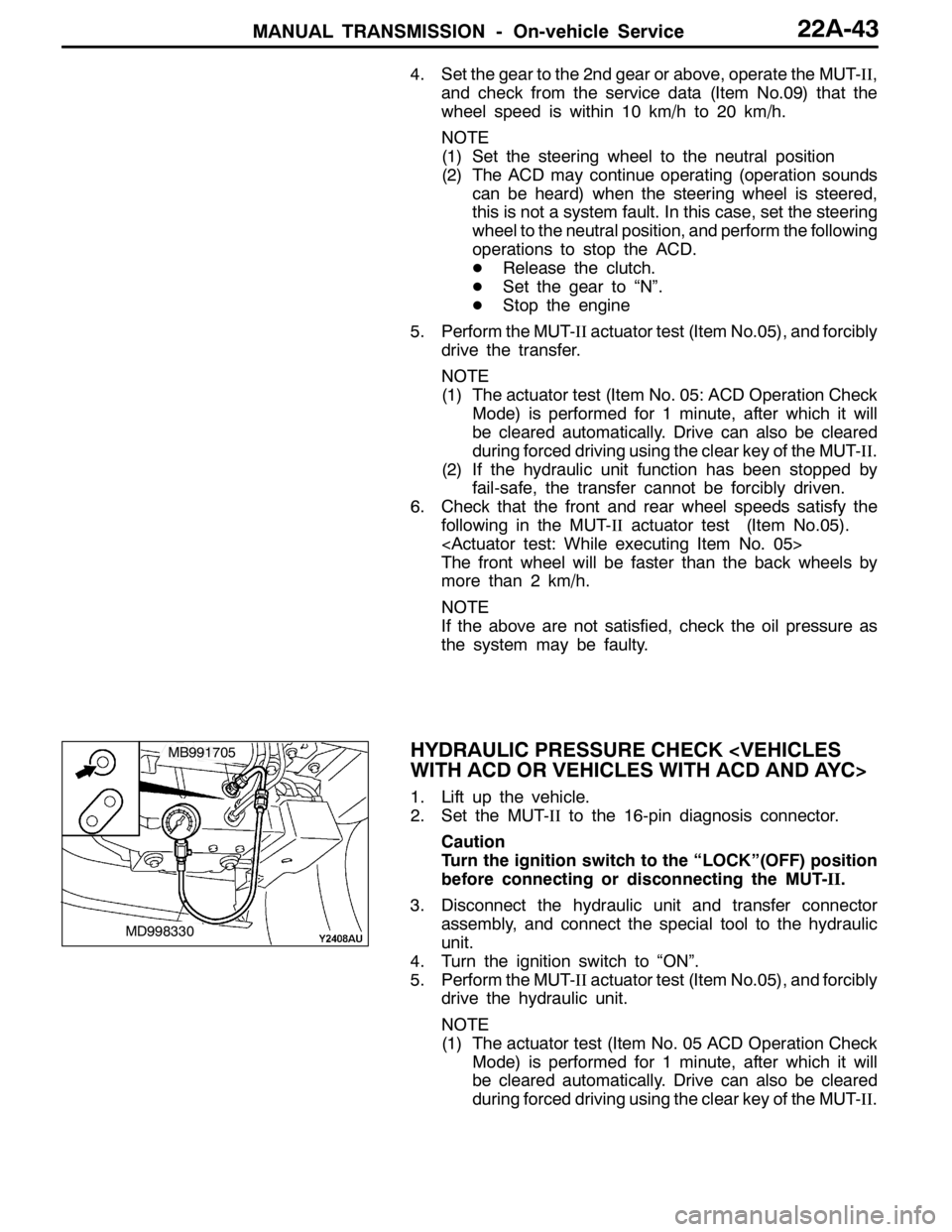
MANUAL TRANSMISSION - On-vehicle Service22A-43
4. Set the gear to the 2nd gear or above, operate the MUT-II,
and check from the service data (Item No.09) that the
wheel speed is within 10 km/h to 20 km/h.
NOTE
(1) Set the steering wheel to the neutral position
(2) The ACD may continue operating (operation sounds
can be heard) when the steering wheel is steered,
this is not a system fault. In this case, set the steering
wheel to the neutral position, and perform the following
operations to stop the ACD.
DRelease the clutch.
DSet the gear to “N”.
DStop the engine
5. Perform the MUT-IIactuator test (Item No.05), and forcibly
drive the transfer.
NOTE
(1) The actuator test (Item No. 05: ACD Operation Check
Mode) is performed for 1 minute, after which it will
be cleared automatically. Drive can also be cleared
during forced driving using the clear key of the MUT-II.
(2) If the hydraulic unit function has been stopped by
fail-safe, the transfer cannot be forcibly driven.
6. Check that the front and rear wheel speeds satisfy the
following in the MUT-IIactuator test (Item No.05).
The front wheel will be faster than the back wheels by
more than 2 km/h.
NOTE
If the above are not satisfied, check the oil pressure as
the system may be faulty.
HYDRAULIC PRESSURE CHECK
1. Lift up the vehicle.
2. Set the MUT-IIto the 16-pin diagnosis connector.
Caution
Turn the ignition switch to the “LOCK”(OFF) position
before connecting or disconnecting the MUT-II.
3. Disconnect the hydraulic unit and transfer connector
assembly, and connect the special tool to the hydraulic
unit.
4. Turn the ignition switch to “ON”.
5. Perform the MUT-IIactuator test (Item No.05), and forcibly
drive the hydraulic unit.
NOTE
(1) The actuator test (Item No. 05 ACD Operation Check
Mode) is performed for 1 minute, after which it will
be cleared automatically. Drive can also be cleared
during forced driving using the clear key of the MUT-II.
MD998330
MB991705
Page 852 of 1449

MANUAL TRANSMISSION - On-vehicle Service22A-44
(2) If the hydraulic unit function has been stopped by
fail-safe, the hydraulic unit cannot be forcibly driven.
6. Check that the generated oil pressure of the hydraulic
unit satisfies the standard value.
Standard value: 1.0 – 1.6 MPa
Caution
While the oil pressure is checked, add fluid as
necessary to ensure that it is left in the oil reservoir
during the entire procedure.
7. If the measured value exceeds the standard value, replace
the hydraulic unit.
8. Connect the hydraulic unit and transfer connector
assembly, and tighten the flare nut at the specified torque.
Tightening torque: 34±5 N·m (when screw is dry)
26±4 N·m (when screw is applied with oil)
9. Supply the specified fluid up to the MAX level of the
oil reservoir, and bleed the oil pressure pipes.
Specified fluid: DIA QUEEN ATF SP III
Quantity:
0.9 dm
3
1.0 dm3
WHEEL SPEED SENSOR OUTPUT VOLTAGE
MEASUREMENT
1. Lift the vehicle, and release the parking brake.
2. Disconnect the 4WD-ECU connector, and measure at
the connector of the harness.
Caution
Insert the probe from the harness of the connector.
Inserting in the terminal side may cause contact fault.
3. Rotate the measured wheel by about 1/2 to 1
rotations/second, and check the output voltage between
the following terminals using a circuit tester (AC mV range)
or oscilloscope.
Terminal No.
Front leftFront rightRear leftRear right
6987
19222120
Page 853 of 1449
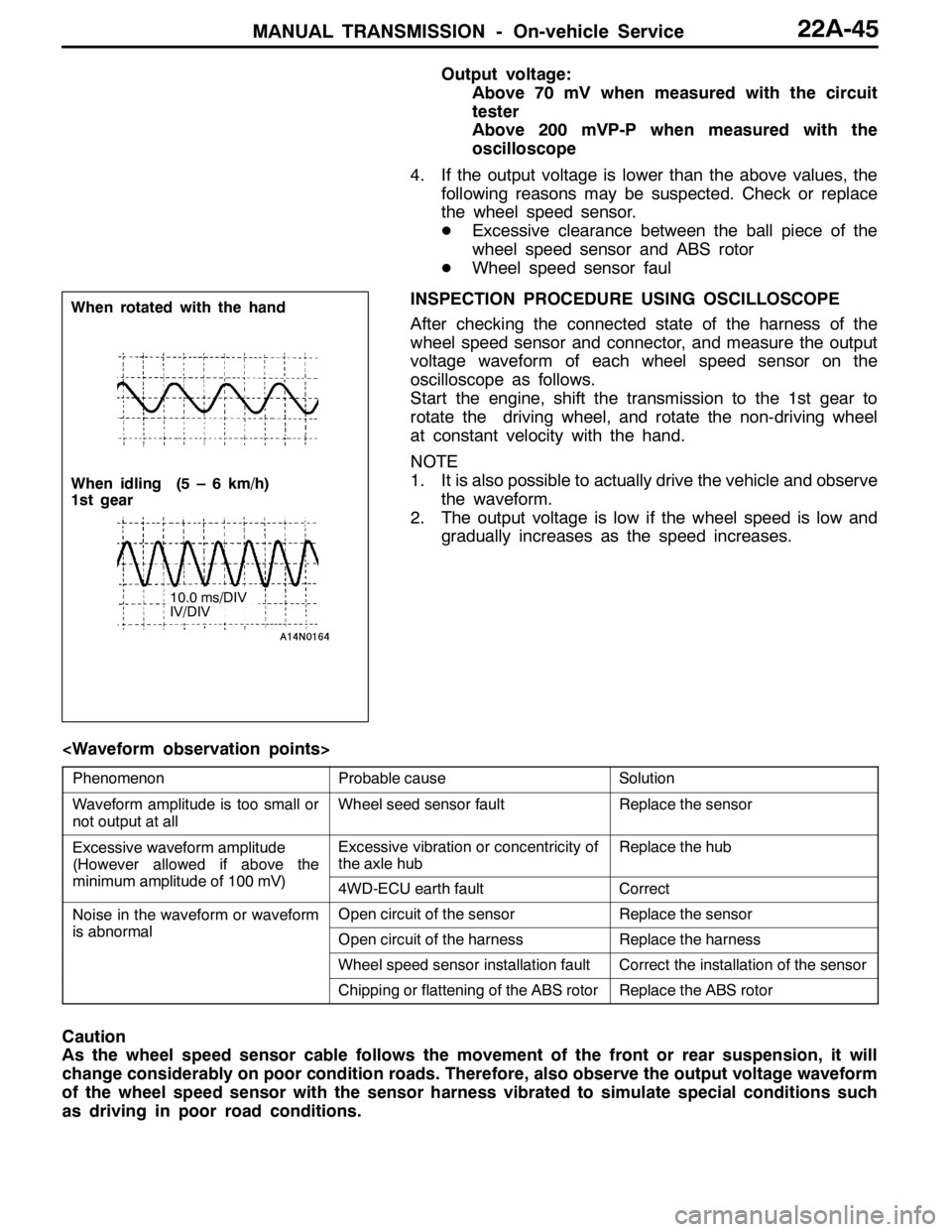
MANUAL TRANSMISSION - On-vehicle Service22A-45
Output voltage:
Above 70 mV when measured with the circuit
tester
Above 200 mVP-P when measured with the
oscilloscope
4. If the output voltage is lower than the above values, the
following reasons may be suspected. Check or replace
the wheel speed sensor.
DExcessive clearance between the ball piece of the
wheel speed sensor and ABS rotor
DWheel speed sensor faul
INSPECTION PROCEDURE USING OSCILLOSCOPE
After checking the connected state of the harness of the
wheel speed sensor and connector, and measure the output
voltage waveform of each wheel speed sensor on the
oscilloscope as follows.
Start the engine, shift the transmission to the 1st gear to
rotate the driving wheel, and rotate the non-driving wheel
at constant velocity with the hand.
NOTE
1. It is also possible to actually drive the vehicle and observe
the waveform.
2. The output voltage is low if the wheel speed is low and
gradually increases as the speed increases.
PhenomenonProbable causeSolution
Waveform amplitude is too small or
not output at allWheel seed sensor faultReplace the sensor
Excessive waveform amplitude
(However allowed if above the
iilit df100V)
Excessive vibration or concentricity of
the axle hubReplace the hub
(
minimum amplitude of 100 mV)4WD-ECU earth faultCorrect
Noise in the waveform or waveform
ibl
Open circuit of the sensorReplace the sensor
is abnormalOpen circuit of the harnessReplace the harness
Wheel speed sensor installation faultCorrect the installation of the sensor
Chipping or flattening of the ABS rotorReplace the ABS rotor
Caution
As the wheel speed sensor cable follows the movement of the front or rear suspension, it will
change considerably on poor condition roads. Therefore, also observe the output voltage waveform
of the wheel speed sensor with the sensor harness vibrated to simulate special conditions such
as driving in poor road conditions.
When rotated with the hand
When idling (5 – 6 km/h)
1st gear
10.0 ms/DIV
IV/DIV
Page 854 of 1449
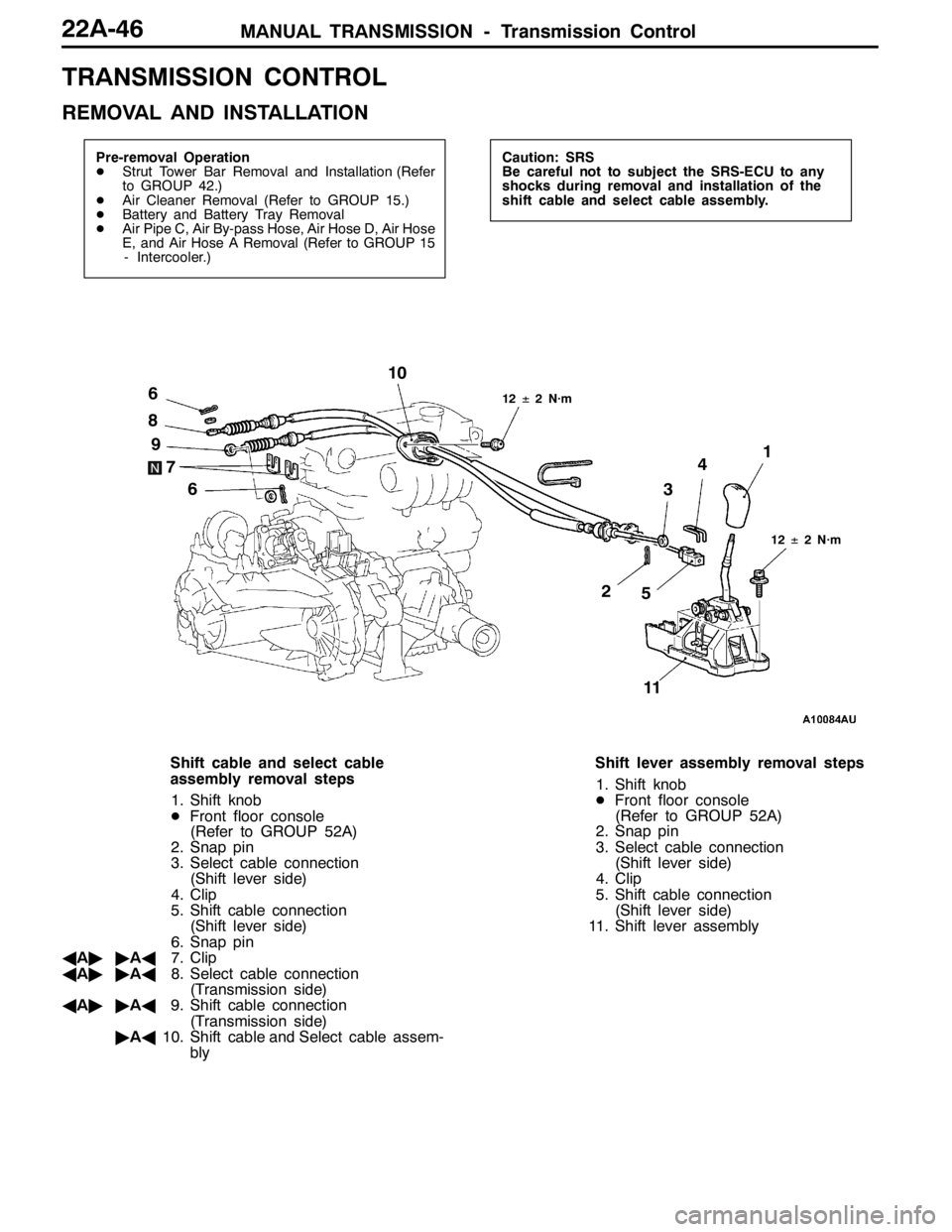
MANUAL TRANSMISSION - Transmission Control22A-46
TRANSMISSION CONTROL
REMOVAL AND INSTALLATION
Pre-removal Operation
DStrut Tower Bar Removal and Installation (Refer
to GROUP 42.)
DAir Cleaner Removal (Refer to GROUP 15.)
DBattery and Battery Tray Removal
DAir Pipe C, Air By-pass Hose, Air Hose D, Air Hose
E, and Air Hose A Removal (Refer to GROUP 15
- Intercooler.)Caution: SRS
Be careful not to subject the SRS-ECU to any
shocks during removal and installation of the
shift cable and select cable assembly.
12±2 N·m
34
21
5 6
7 8
6 910
12±2 N·m
11
Shift cable and select cable
assembly removal steps
1. Shift knob
DFront floor console
(Refer to GROUP 52A)
2. Snap pin
3. Select cable connection
(Shift lever side)
4. Clip
5. Shift cable connection
(Shift lever side)
6. Snap pin
AA""AA7. Clip
AA""AA8. Select cable connection
(Transmission side)
AA""AA9. Shift cable connection
(Transmission side)
"AA10. Shift cable and Select cable assem-
blyShift lever assembly removal steps
1. Shift knob
DFront floor console
(Refer to GROUP 52A)
2. Snap pin
3. Select cable connection
(Shift lever side)
4. Clip
5. Shift cable connection
(Shift lever side)
11. Shift lever assembly
Page 855 of 1449
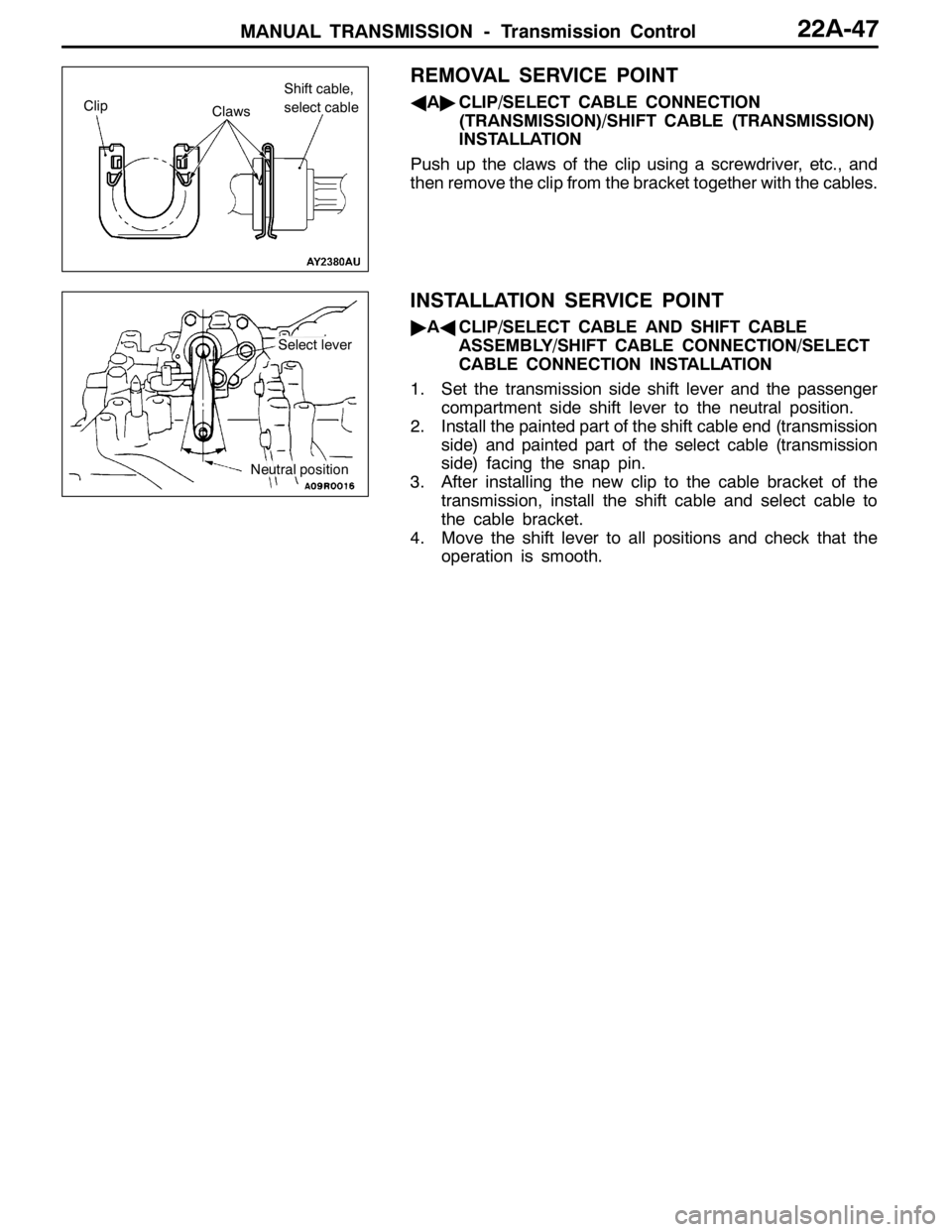
MANUAL TRANSMISSION - Transmission Control22A-47
REMOVAL SERVICE POINT
AA"CLIP/SELECT CABLE CONNECTION
(TRANSMISSION)/SHIFT CABLE (TRANSMISSION)
INSTALLATION
Push up the claws of the clip using a screwdriver, etc., and
then remove the clip from the bracket together with the cables.
INSTALLATION SERVICE POINT
"AACLIP/SELECT CABLE AND SHIFT CABLE
ASSEMBLY/SHIFT CABLE CONNECTION/SELECT
CABLE CONNECTION INSTALLATION
1. Set the transmission side shift lever and the passenger
compartment side shift lever to the neutral position.
2. Install the painted part of the shift cable end (transmission
side) and painted part of the select cable (transmission
side) facing the snap pin.
3. After installing the new clip to the cable bracket of the
transmission, install the shift cable and select cable to
the cable bracket.
4. Move the shift lever to all positions and check that the
operation is smooth.
Clip
Claws
Shift cable,
select cable
Neutral position
Select lever
Page 856 of 1449
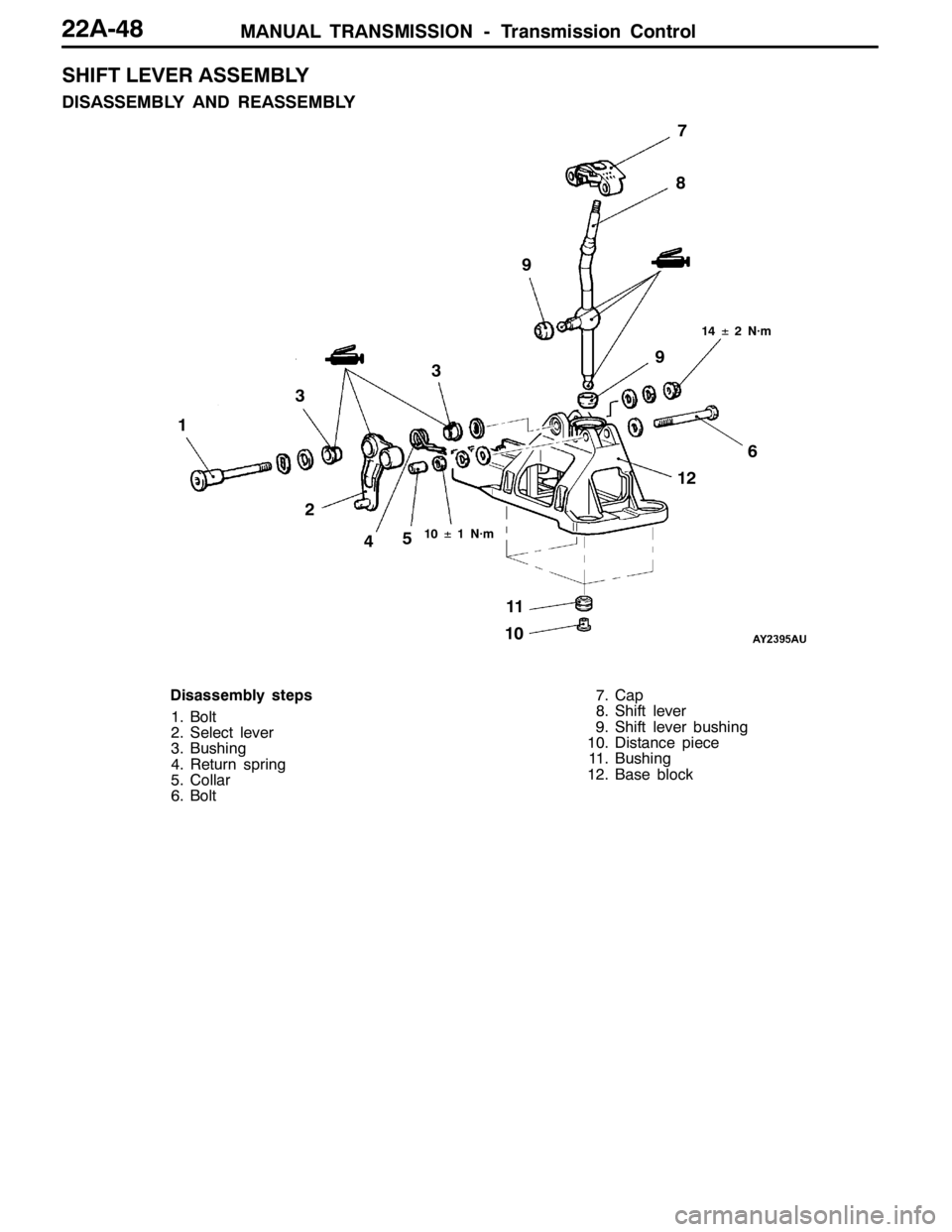
MANUAL TRANSMISSION - Transmission Control22A-48
SHIFT LEVER ASSEMBLY
DISASSEMBLY AND REASSEMBLY
2
3
47
8
109
1
56 9
3
1112
14±2 N·m
10±1 N·m
Disassembly steps
1. Bolt
2. Select lever
3. Bushing
4. Return spring
5. Collar
6. Bolt7. Cap
8. Shift lever
9. Shift lever bushing
10. Distance piece
11. Bushing
12. Base block
Page 857 of 1449
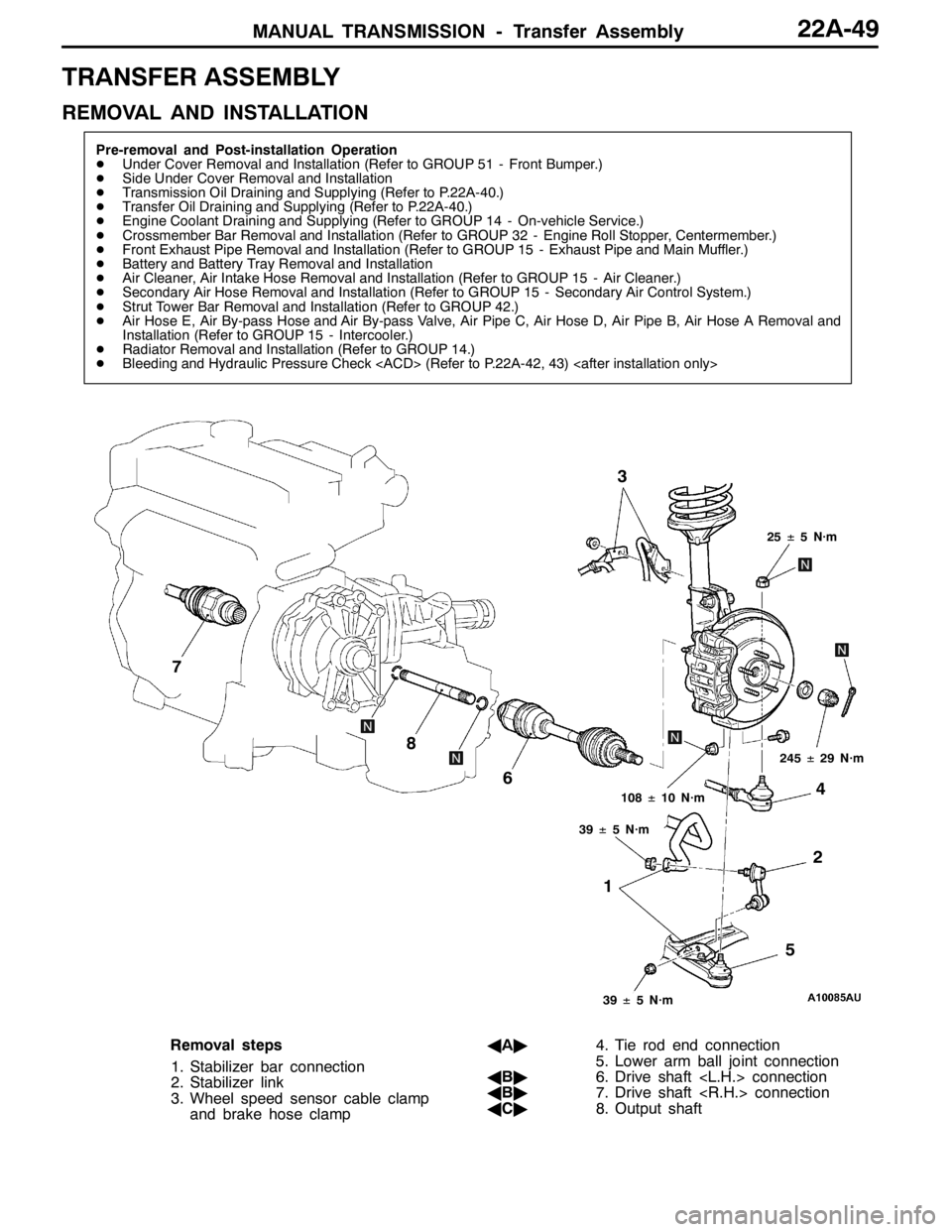
MANUAL TRANSMISSION - Transfer Assembly22A-49
TRANSFER ASSEMBLY
REMOVAL AND INSTALLATION
Pre-removal and Post-installation Operation
DUnder Cover Removal and Installation (Refer to GROUP 51 - Front Bumper.)
DSide Under Cover Removal and Installation
DTransmission Oil Draining and Supplying (Refer to P.22A-40.)
DTransfer Oil Draining and Supplying (Refer to P.22A-40.)
DEngine Coolant Draining and Supplying (Refer to GROUP 14 - On-vehicle Service.)
DCrossmember Bar Removal and Installation (Refer to GROUP 32 - Engine Roll Stopper, Centermember.)
DFront Exhaust Pipe Removal and Installation (Refer to GROUP 15 - Exhaust Pipe and Main Muffler.)
DBattery and Battery Tray Removal and Installation
DAir Cleaner, Air Intake Hose Removal and Installation (Refer to GROUP 15 - Air Cleaner.)
DSecondary Air Hose Removal and Installation (Refer to GROUP 15 - Secondary Air Control System.)
DStrut Tower Bar Removal and Installation (Refer to GROUP 42.)
DAir Hose E, Air By-pass Hose and Air By-pass Valve, Air Pipe C, Air Hose D, Air Pipe B, Air Hose A Removal and
Installation (Refer to GROUP 15 - Intercooler.)
DRadiator Removal and Installation (Refer to GROUP 14.)
DBleeding and Hydraulic Pressure Check
12 3
4
5 6 7
8
25±5 N·m
108±10 N·m
39±5 N·m
39±5 N·m
245±29 N·m
Removal steps
1. Stabilizer bar connection
2. Stabilizer link
3. Wheel speed sensor cable clamp
and brake hose clampAA"4. Tie rod end connection
5. Lower arm ball joint connection
AB"6. Drive shaft
AB"7. Drive shaft
AC"8. Output shaft
Page 858 of 1449
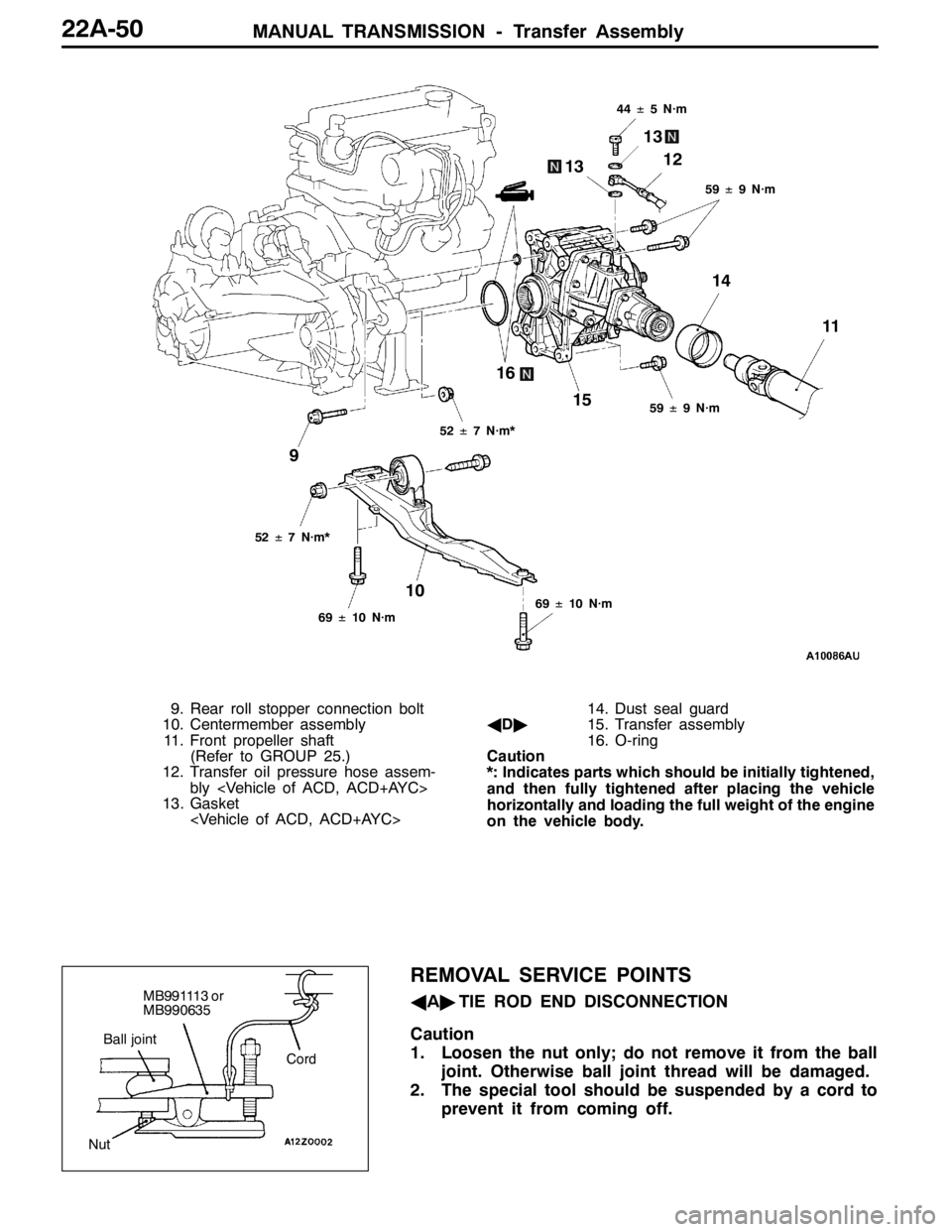
MANUAL TRANSMISSION - Transfer Assembly22A-50
11 12
9
1013
14
15 16
13
59±9 N·m
59±9 N·m
44±5 N·m
69±10 N·m
52±7 N·m*
52±7 N·m*
69±10 N·m
9. Rear roll stopper connection bolt
10. Centermember assembly
11. Front propeller shaft
(Refer to GROUP 25.)
12. Transfer oil pressure hose assem-
bly
13. Gasket
AD"15. Transfer assembly
16. O-ring
Caution
*: Indicates parts which should be initially tightened,
and then fully tightened after placing the vehicle
horizontally and loading the full weight of the engine
on the vehicle body.
REMOVAL SERVICE POINTS
AA"TIE ROD END DISCONNECTION
Caution
1. Loosen the nut only; do not remove it from the ball
joint. Otherwise ball joint thread will be damaged.
2. The special tool should be suspended by a cord to
prevent it from coming off.MB991113 or
MB990635
Cord Ball joint
Nut
Page 859 of 1449
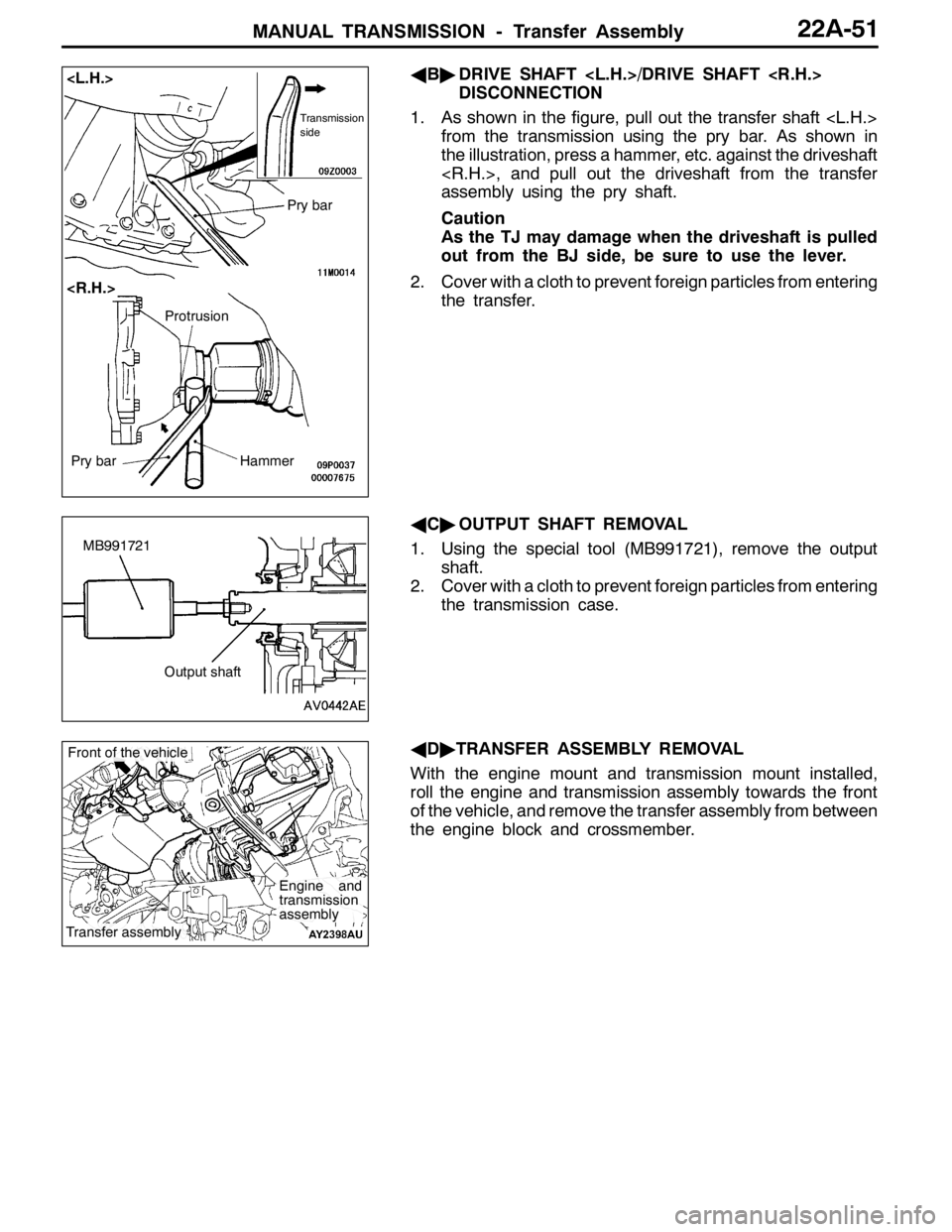
MANUAL TRANSMISSION - Transfer Assembly22A-51
AB"DRIVE SHAFT
DISCONNECTION
1. As shown in the figure, pull out the transfer shaft
from the transmission using the pry bar. As shown in
the illustration, press a hammer, etc. against the driveshaft
assembly using the pry shaft.
Caution
As the TJ may damage when the driveshaft is pulled
out from the BJ side, be sure to use the lever.
2. Cover with a cloth to prevent foreign particles from entering
the transfer.
AC"OUTPUT SHAFT REMOVAL
1. Using the special tool (MB991721), remove the output
shaft.
2. Cover with a cloth to prevent foreign particles from entering
the transmission case.
AD"TRANSFER ASSEMBLY REMOVAL
With the engine mount and transmission mount installed,
roll the engine and transmission assembly towards the front
of the vehicle, and remove the transfer assembly from between
the engine block and crossmember.
Transmission
side
Pry bar
Pry barHammer
Protrusion
MB991721
Output shaft
Engine and
transmission
assembly
Transfer assembly
Front of the vehicle
Page 860 of 1449
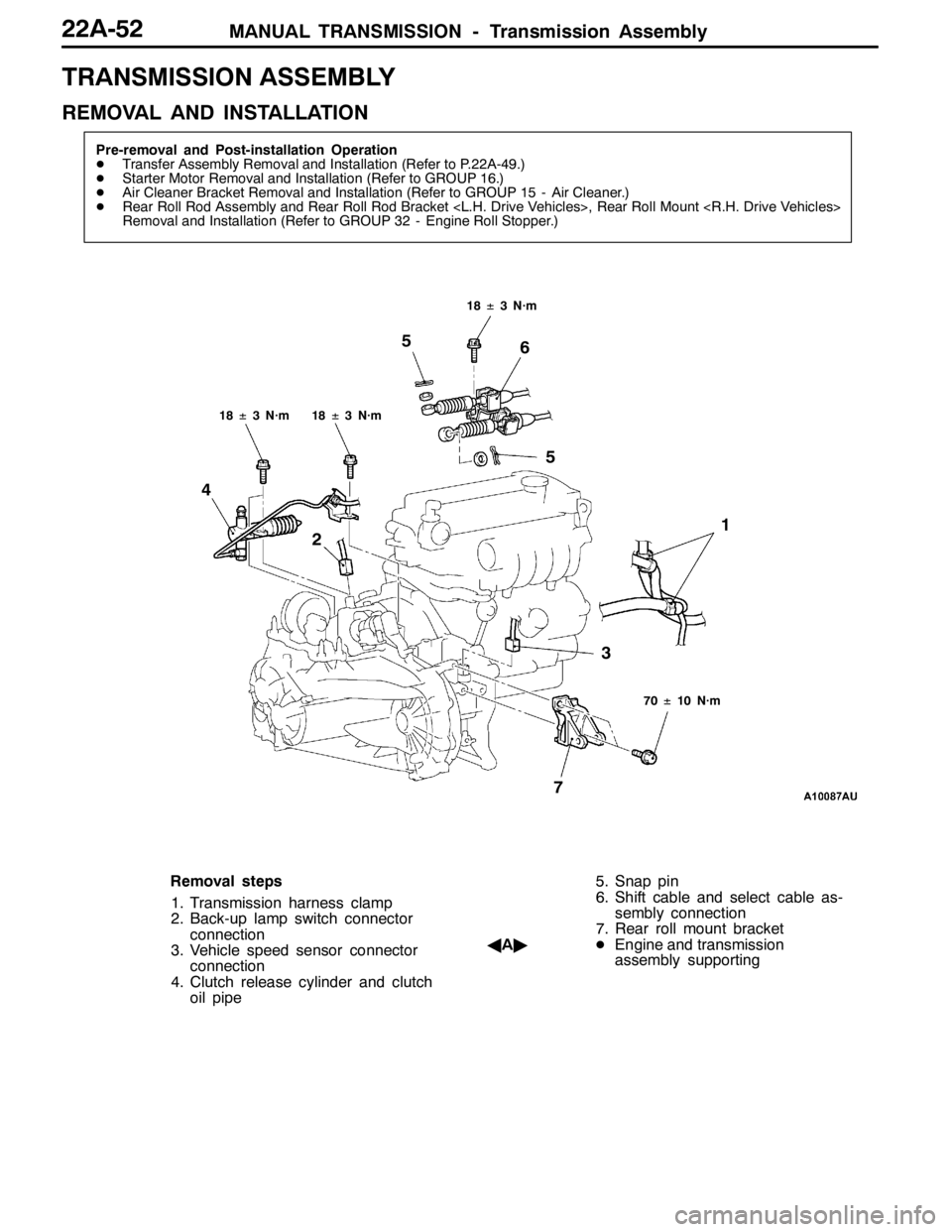
MANUAL TRANSMISSION - Transmission Assembly22A-52
TRANSMISSION ASSEMBLY
REMOVAL AND INSTALLATION
Pre-removal and Post-installation Operation
DTransfer Assembly Removal and Installation (Refer to P.22A-49.)
DStarter Motor Removal and Installation (Refer to GROUP 16.)
DAir Cleaner Bracket Removal and Installation (Refer to GROUP 15 - Air Cleaner.)
DRear Roll Rod Assembly and Rear Roll Rod Bracket
Removal and Installation (Refer to GROUP 32 - Engine Roll Stopper.)
1
2
3 45
5 6
7
18±3 N·m18±3 N·m
18±3 N·m
70±10 N·m
Removal steps
1. Transmission harness clamp
2. Back-up lamp switch connector
connection
3. Vehicle speed sensor connector
connection
4. Clutch release cylinder and clutch
oil pipe5. Snap pin
6. Shift cable and select cable as-
sembly connection
7. Rear roll mount bracket
AA"DEngine and transmission
assembly supporting